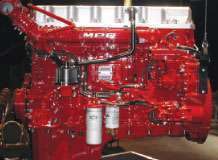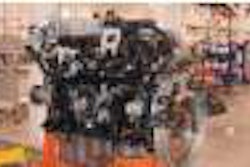A clean sweep
Crankcase ventilation system upkeep helps both engines, environment
Crankcase blow-by is hot gases that sneak past the piston rings. As of 2007, the U.S. Environmental Protection Agency limits nonmethane hydrocarbons to 0.14 grams per bhp-hr. Blow-by gases are rich in them because they travel through oil on the cylinder walls. To keep those hydrocarbons out of the air, crankcase ventilation systems were installed on truck diesels.
Systems may be OCV for open crankcase ventilation or CCV for closed crankcase ventilation. OCV systems are common on heavy-duty engines, expelling cleaned blow-by gases through a tube. Closed systems bring the gases into the suction side of the turbocharger; the filtration allows much of the blow-by gas, which also retains emissions, to be reburned without causing the turbo and charge air cooler to soot up.
 The crankcase ventilation system for Mack’s MP8 engine shows: (1) the engine outlet for crankcase gases, (2) the separator where crankcase gas is condensed, (3) the condensed oil return to the crankcase and (4) the decondensed crankcase gas that is returned for combustion.
The crankcase ventilation system for Mack’s MP8 engine shows: (1) the engine outlet for crankcase gases, (2) the separator where crankcase gas is condensed, (3) the condensed oil return to the crankcase and (4) the decondensed crankcase gas that is returned for combustion.The system is simple and inexpensive to maintain, and provides some side benefits. The aftermarket version of the Cummins CV51118 system is designed to reduce emissions, oil consumption, mist, fumes and drips in the engine compartment. Volvo’s system contains a spinning element that allows it to remove oil droplets and impurities via centrifugal force; recovered engine oil enters the lubrication system, where it passes through the full-flow filters prior to reaching the moving parts.
Required system maintenance varies by make and generally includes filter service and an inspection of all hoses for cracks or brittleness, as well as all connections. Cummins uses a coalescing filter that needs to be replaced at intervals that vary with the type of service experienced by the truck; the filter is accessed by loosening the attaching bolts and removing the cover of the filter housing. The Volvo system requires no routine maintenance, says Jim Fancher, the company’s powertrain product marketing manager.
Caterpillar’s heavy-duty engines have an open system, while its Class 5-7 truck engines have a closed system. The heavy-duty engines need a replacement filter every 50,000 miles/1,500 hours, while medium-duty engines need the ventilation tube disconnected and cleaned at the exhaust system every 90,000 miles/1,500 hours, says Brent Cluskey, highway engines technical steward.
A malfunctioning CV system can spell trouble for an unwary maintenance manager.
Mack’s system returns some of the actual gases back to the air intake for combustion, and simultaneously condenses liquids out of the remainder, returning oil to the crankcase. The system, which employs a recleanable mesh filter to weed out engine oil mist and impurities, should be inspected annually, and the filter should be cleaned at the same time if it appears to be clogged.
For all makes, a system malfunction might lead to high crankcase pressure. “Internal crankcase pressures may continue to build up over time, which can contribute to oil leakage in and around the gaskets and O-rings,” says Mack’s Dave McKenna. For Volvo, a numerical failure code will appear on the driver display. “If technicians see suspicious external leaks from the engine’s lubrication system, they should check for such a code, then inspect the system if one is present,” Fancher says.
For the Cummins Filtration CCV system, high crankcase pressure may dislodge the engine oil level dipstick – a symptom that would suggest inspection of the system is warranted. n









